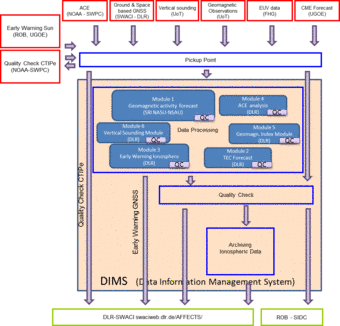Forecast System Ionosphere
To reduce the impact of space weather phenomena on the functionality of space based radio systems, early warnings and forecasts of expected ionospheric and geomagnetic perturbations shall be deduced from solar, geomagnetic and ionospheric data. This requires to process the observations as fast as possible in near real time and to run specific forecast tools to provide ionospheric and geomagnetic predictions in time.
Therefore, the Forecast System Ionosphere (FSI), which is designed to respond to these needs, is a major part of the AFFECTS system. It is supposed to provide the near real time processing and delivery of space weather products developed within AFFECTS. This includes e.g. the geomagnetic activity forecast, the TEC perturbation forecast and the provision of the early warning message for GNSS users. The FSI is implemented as a subsystem of the currently running SWACI system at the DLR in Neustrelitz.
The figure below provides an overview of the system architecture of the FSI. Each AFFECTS consortium member is contributing to the FSI either by data provision or by providing software for processing modules.
The different data inputs to the FSI are specified in red boxes. This includes the solar, GNSS, vertical sounding data and geomagnetic observations. The solar Early Warning message is provided by UGOE, ROB (based on NOAA-SWPC) to the FSI for European distribution and forecast. The data processing includes 6 modules and each of the processing modules incorporates a product specific Quality Check (QC). In addition the FSI contains an overall QC for the system. The generated space weather products will be distributed via this website.
The FSI uses existing and approved systems like the Data Information Management System (DIMS), the Processing System Management (PSM) and the DIMS Product Library (PL), which are already operating in SWACI system at DLR. The assets of these systems are inter alia flexibility, controlling and extensibility. The DIMS with the PSM is the data processing environment. PSMs will control the modules as well as the distribution of the output products to this SWACI-AFFECTS website and to the data archive. For archiving of the AFFECTS products the PL is used.
For more information please read this link: INFO








